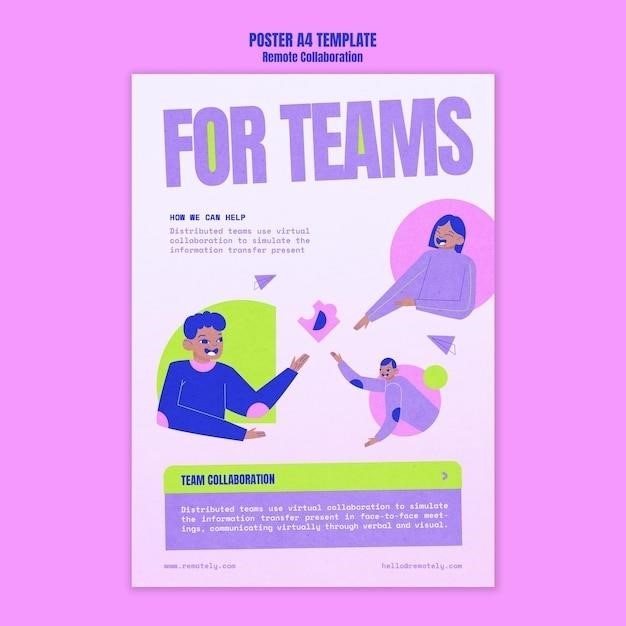What is a Team Charter?
A team charter is a foundational document outlining a team’s purpose, goals, roles, and working agreements․ It fosters collaboration and accountability, ensuring everyone is on the same page․
Purpose and Importance
A team charter serves as a roadmap, guiding a team towards shared objectives․ Its primary purpose is to establish a clear understanding of the team’s mission, goals, and individual responsibilities․ This shared understanding minimizes misunderstandings and conflicts, improving communication and collaboration․ A well-defined charter enhances team cohesion by providing a framework for decision-making and conflict resolution․ It promotes accountability by outlining individual roles and expectations, ensuring everyone contributes effectively․ Furthermore, a team charter acts as a reference point throughout the project lifecycle, helping maintain focus and track progress․ By clearly defining team values and working styles, it fosters a positive and productive team environment․ The importance of a team charter cannot be overstated, particularly in complex projects or when working remotely․ It ensures everyone is aligned and working towards the same outcome, ultimately leading to improved project success․
Key Elements of a Successful Charter
A truly effective team charter incorporates several crucial elements․ First, a concise and compelling statement of the team’s purpose is essential, clearly outlining its overall objective․ Next, specific, measurable, achievable, relevant, and time-bound (SMART) goals must be defined, providing clear targets for the team to strive towards․ Clearly defined roles and responsibilities for each team member are also critical, avoiding ambiguity and overlap․ Effective communication protocols, including meeting schedules, reporting procedures, and preferred communication channels, must be established․ Furthermore, a set of ground rules for team interactions should be agreed upon, fostering respectful collaboration and efficient decision-making․ Finally, a process for addressing conflicts and challenges should be outlined, providing a structured approach to resolving disagreements and maintaining team unity․ These elements work in concert to create a robust and functional team charter․
Creating Your Team Charter⁚ A Step-by-Step Guide
This section provides a structured approach to crafting a comprehensive and effective team charter, guiding you through each critical step․
Defining Team Purpose and Objectives
Clearly articulate the team’s overall purpose and mission․ What problem are you solving? What are you aiming to achieve? Define specific, measurable, achievable, relevant, and time-bound (SMART) objectives; These objectives should align with the broader organizational goals and provide a clear roadmap for the team’s activities․ Consider using the examples provided in various team charter templates available online as a starting point․ Ensure that the purpose and objectives are concisely stated and easily understood by all team members․ This clarity ensures everyone works towards the same goals, preventing confusion and wasted effort․ Regularly reviewing and updating these objectives is crucial to ensure they remain relevant and aligned with evolving priorities․
Establishing Roles and Responsibilities
Explicitly define each team member’s role and responsibilities․ Avoid ambiguity by clearly outlining individual tasks and accountabilities․ This section should detail who is responsible for what, preventing overlaps or gaps in responsibility․ Consider using a table format to clearly list roles, responsibilities, and associated tasks; This structured approach ensures that every team member understands their contribution and how it connects to the overall team goals․ Reference examples from various downloadable team charter templates to optimize this section’s clarity and effectiveness․ A well-defined roles section minimizes confusion and conflict, fostering efficient workflow and accountability․
Setting Ground Rules and Communication Protocols
Establish clear communication guidelines to ensure efficient and effective teamwork․ Specify preferred communication methods (email, instant messaging, meetings), response times, and meeting frequency․ Define how decisions will be made (consensus, voting, majority rule) and document the process for conflict resolution․ Address meeting etiquette, including punctuality, preparation, and participation expectations․ Outline procedures for handling disagreements or roadblocks, promoting a respectful and productive environment․ Consider including guidelines on feedback delivery, ensuring constructive and timely feedback exchange․ These protocols streamline communication, preventing misunderstandings and promoting a cohesive team dynamic;

Team Charter Templates and Examples
Access downloadable templates in various formats (PDF, Word, Excel) and explore examples tailored to different team structures (Agile, Six Sigma, etc․)․
Downloadable Templates in Various Formats
To streamline the process of creating your team charter, readily available downloadable templates offer a significant advantage․ These templates, typically found online or through project management software, come in a variety of formats to suit individual preferences and software compatibility․ Common formats include Microsoft Word (․doc or ․docx), Excel (․xls or ․xlsx), and Adobe PDF (․pdf)․ The versatility of these formats allows for easy customization and sharing within the team․ Choosing the right format depends on your team’s familiarity with different software packages and the level of collaboration required during the creation process․ Some templates even offer interactive features, facilitating collaborative input and ensuring everyone’s voice is heard in shaping the final document․ Regardless of the format selected, a well-structured template will guide you through the key elements of a successful team charter, ensuring clarity and consistency throughout the document․
Examples of Team Charters for Different Team Types (Agile, Six Sigma, etc․)
Team charters aren’t one-size-fits-all; their structure and content should adapt to the specific methodology and needs of the team․ For instance, an Agile team’s charter might emphasize iterative progress, frequent communication, and adaptability to changing requirements․ It would likely include sections on sprint planning, daily stand-ups, and retrospectives․ Conversely, a Six Sigma team’s charter would prioritize process improvement, data analysis, and adherence to defined methodologies․ It might detail specific metrics for success, DMAIC phases, and roles within the team․ Exploring examples tailored to different team types (like Agile, Six Sigma, project management, or cross-functional teams) is valuable․ These examples offer insights into how to structure your charter effectively, highlighting essential elements relevant to your team’s context․ By referencing such examples, you can ensure your charter comprehensively addresses your team’s unique challenges and goals․
Utilizing Your Team Charter for Effective Teamwork
Regularly review and update the charter to ensure it remains relevant and effective for ongoing teamwork․
Implementing and Maintaining the Charter
After creation, the team charter isn’t a static document; it’s a living, breathing agreement that requires consistent attention․ Regularly scheduled reviews, perhaps monthly or quarterly, depending on project length and team dynamics, are crucial․ These reviews should involve the entire team to discuss its effectiveness․ Are the established goals still relevant? Are the defined roles working as intended? Are the communication protocols facilitating efficient collaboration, or are adjustments needed? Document any changes made during these reviews, updating the charter accordingly․ This ensures that the charter remains a valuable tool throughout the project lifecycle, promoting consistent teamwork and shared understanding․ Consider using a shared online document for easy access and collaborative editing․ This approach fosters transparency and ensures everyone is aware of the latest version․ By actively maintaining and updating the charter, teams can adapt to changing circumstances and sustain their effectiveness․
Addressing Challenges and Resolving Conflicts
A well-defined team charter proactively addresses potential conflict by establishing clear communication protocols and decision-making processes․ When disagreements arise, the charter serves as a reference point, guiding the team towards a resolution․ The established ground rules, for instance, on respectful communication and conflict resolution strategies, provide a framework for navigating disagreements constructively․ If the charter outlines a specific process for conflict resolution, such as mediation or voting procedures, the team can follow these steps to find a solution․ Regular team meetings, as stipulated within the charter, provide a forum for open discussion and early identification of potential conflicts before they escalate․ By referring to the agreed-upon guidelines within the charter, team members can work collaboratively to overcome challenges and maintain a productive working environment․ The charter’s focus on shared understanding and accountability helps facilitate effective conflict resolution, fostering a positive team dynamic․

Benefits of Using a Team Charter
Team charters boost communication, collaboration, and accountability, leading to increased efficiency and project success;
Improved Communication and Collaboration
A well-defined team charter significantly enhances communication and collaboration by establishing clear expectations and ground rules․ It provides a shared understanding of roles, responsibilities, and decision-making processes, minimizing misunderstandings and conflicts․ The document serves as a central repository of information, readily accessible to all team members․ This accessibility ensures everyone stays informed about project progress, deadlines, and any changes in direction․ By outlining communication protocols, the charter promotes efficient information flow, facilitating smoother teamwork and faster problem-solving․ The structured approach reduces ambiguity and encourages open dialogue, fostering a collaborative environment where team members feel comfortable contributing their ideas and expertise․ Ultimately, improved communication and collaboration translate to increased team cohesion and productivity․
Increased Accountability and Efficiency
Team charters foster accountability by clearly defining individual roles and responsibilities․ Each member understands their contribution to the overall goals, promoting a sense of ownership and commitment․ This clarity reduces ambiguity and overlap, ensuring everyone focuses on their designated tasks․ The established decision-making processes outlined in the charter streamline workflows, preventing delays caused by indecision or conflicting viewpoints․ By setting clear expectations for performance and outlining consequences for non-compliance, the charter reinforces a culture of responsibility․ This structured approach eliminates guesswork and empowers team members to work independently while knowing their actions align with the team’s objectives․ The resulting efficiency boosts productivity, allowing the team to achieve its goals more effectively and within allocated timelines․ Ultimately, increased accountability and efficiency contribute to a more successful and productive team dynamic․
